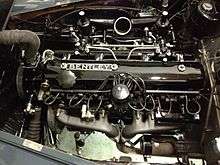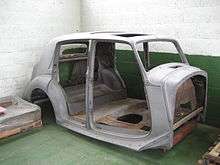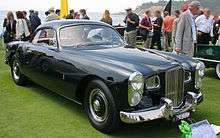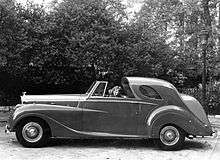Bentley Mark VI
| Bentley Mark VI | |
|---|---|
.jpg) 1947 standard steel sports saloon | |
| Overview | |
| Manufacturer | Bentley Motors (1931) Limited, Crewe Cheshire |
| Production |
1946–1952 5208 produced[1] |
| Assembly | Crewe, England |
| Body and chassis | |
| Class | Full-size luxury car |
| Body style |
4-door saloon [2] 2-door saloon [2] 2-door drophead coupe [2] chassis only [2] (for coachbuilt bodies) |
| Layout | FR layout |
| Related | Rolls-Royce Silver Dawn |
| Powertrain | |
| Engine |
4 1⁄4-litre 4.3 L I6 4 1⁄2-litre 4.6 L I6 |
| Transmission | 4-speed manual |
| Dimensions | |
| Wheelbase | 120 in (3,048 mm)[3] |
| Length | 192 in (4,877 mm)[3] |
| Width | 70 in (1,778 mm)[3] |
| Height | 64.5 in (1,638 mm)[3] |
| Kerb weight | 4,078 lb (1,850 kg) |
| Chronology | |
| Predecessor | Mark V |
| Successor | R Type |
The Bentley Mark VI is an automobile from Bentley which was produced from 1946 to 1952.
The Mark VI 4-door standard steel sports saloon was the first post-war luxury car from Bentley. Announced in May 1946[4] and produced from 1946 to 1952 it was also both the first car from Rolls-Royce with all-steel coachwork and the first complete car assembled and finished at their factory. These very expensive cars were a genuine success, long-term their weakness lay in the inferior steels forced on them by government's post-war controls.[5] Chassis continued to be supplied to independent coachbuilders. Four-door Saloon, two-door saloon and drophead coupe models with bodies by external companies were listed by Bentley along with the Bentley-bodied saloon.[2]
This Bentley factory finished car was given the name Bentley Mark VI standard steel sports saloon. This shorter wheelbase chassis and engine was a variant of the Rolls-Royce Silver Wraith of 1946 and, with the same standard steel body and a larger boot became the cautiously introduced Silver Dawn of 1949. The same extended-boot modification was made to the Mark VI body in 1952[6] and the result became known as the R type Bentley.
Mark VI engines and chassis were modified to provide higher performance and sold to be bodied by selected coachbuilders as the first Bentley Continentals, the most expensive production cars in the world and the world's fastest 4/5-seater saloons.
Engine
The Mark VI 4 1⁄4-litre used an F-head straight-6 engine 4.3 L (4,257 cc/259 cu in) in size. The manufacturer refused to disclose a horse power value for the car (other than Tax Horsepower of 29.4 hp according to the old RAC formula) but an Autocar Magazine road test reproduced in 1950 reported that top gear provided "flexibility down to 6 mph (10 km/h)" and the ability to "climb a hill of 1 in 9 maximum gradient, complicated by bends",[7] all of which supported the manufacturer's contention that power, along with low speed torque, were adequate.

In 1951, a 4 1⁄2-litre, 4.6 L (4,566 cc/278 cu in) version of the engine was introduced and then referred to as the big bore engine. A four-speed syncromesh manual transmission was fitted with the change lever to the right of the driver on right hand drive cars and on the column on left hand drive versions.
4 1⁄4-litre cars had chassis numbers from B 1 AJ through B 400 LJ, with the final two letters indicating the series in which it was built. The "big bore" cars serial numbers begin with B 1 MB (although B 2 MD was the first big bore Mark VI built) and ended with B 300 PV (although B 301 PU was the last one built). Each alphabetic series only contained either even or odd numbers, and 13 was always skipped for the odd-numbered sequences.[8]
The 4.3 L was referred to as the 4 1⁄4 L and can be quickly identified from its single exhaust. The 4.6 L is known as the 4 1⁄2 L and features a twin exhaust.
Chassis and running gear
The chassis used leaf springs at the rear and independent coil springing at the front with a control on the steering wheel centre to adjust the hardness of the rear springing by hydraulically adjusting the rear dampers. A pedal-operated central lubrication system allowing oil to be applied to moving parts of the suspension from a central reservoir was fitted. The 12.25 in (311 mm) drum brakes were assisted by the traditional Rolls-Royce mechanical servo.
Standard Steel Saloon

Employing its experience with the steel bodies made in short runs since 1936 by then partly-owned subsidiary Park Ward the Car Division of Rolls-Royce offered their lowest priced chassis with a factory-supplied body all-steel so it could be exported all over the world. The factory bodies with a Gurney-Nutting-Blatchley refined shape were made by Pressed Steel Ltd of Cowley and sent to the Bentley works at Crewe for painting and fitting out with traditional wood and leather. They featured rear hinged "suicide" doors at the front with concealed hinges, a sliding sunroof, a permanently closed windscreen with a defrosting and demisting unit hidden in the scuttle and an electrically controlled heater beneath the front passenger's seat. Twin screenwipers were fitted and provision was made for the fitting of a radio with a short and flexibly mounted aerial that could be swung up above the centre of the screen.
Road test
A 4.6-litre, factory bodied car tested by The Motor magazine in 1951 had a top speed of 100 mph (160 km/h) and could accelerate from 0-60 mph (97 km/h) in 15.0 seconds. A fuel consumption of 16.5 miles per imperial gallon (17.1 L/100 km; 13.7 mpg-US) was recorded. The test car cost £4,473 including taxes.[3]
Commercial
The Mark VI was introduced at a time of steel shortage across Europe which translated into a serious shortage of new cars for sale on the UK market. A Used Car report in 1951 of a three-year-old example with 10,450 miles (16,815 kilometres) on the odometer noted that a car which had, when new, retailed for £4,038 including sales taxes, was now offered for sale at £5,335.[9] This was seen as a comment on the quality of the car but also on the continuing shortage of cars for sale.[9]
By the end of 1952 order-books had shrunk and the Mark VI was replaced by the R-Type, featuring an extended boot/trunk, along with other less visible modifications and newly available home-market options, leading up to the introduction of the completely redesigned S series in 1955.
Production volumes:
- 4 1⁄4 L: 4000 (including 832 with coachbuilt bodies)
- 4 1⁄2 L: 1202 (including 180 with coachbuilt bodies)
Bentley Continental
A Mark VI chassis (at first referred to within the works as Corniche II) was developed by H I F Evernden and J P Blatchley in 1950 and 1951 carrying a larger engine with a higher compression ratio and modified fuel and exhaust systems, a close ratio gearbox and much higher final drive ratio.
By special arrangement with Bentley 2-door bodies were fitted having a lower frontal area and of significantly lighter construction, the first – made by H J Mulliner – developed in conjunction with Evernden and Blatchley. The first still luxurious car was more than 10% lighter than the standard car. They were the most expensive production cars in the world and the world's fastest 4/5-seater saloons.
These chassis were produced between June 1952 and April 1953 and bear the chassis numbers BC1A to BC26A, with the prototype, totalling 27 cars. The engine compression was reduced on the last 8 cars. The bulk of the chassis were clothed by H J Mulliner but some were bodied in Europe. Only the 27 cars were built before the R designation was added to the chassis series identification.[10]
Gallery
- The standard steel saloon and some of the alternatives provided by independent coachbuilders
-

standard steel 4-door
sports saloon -

Figoni & Falaschi Paris
fixed-head coupé 1947 -

Franay Paris
drop-head coupé 1947 -
Freestone & Webb
saloon 1947 -

James Young
sports saloon 1948 -

Park Ward
drophead coupé 1949 -

Stabilimenti Farina
drophead coupé 1949 -

Hooper
sports saloon 1950 -

H.J. Mulliner & Co.
saloon 1951 -

Facel-Métallon Cresta II
fixed head coupé 1951
by Battista Pininfarina -

Cresta II rear view
-

Gurney Nutting
coupé de ville -
Ramseier Brothers
drop-head coupé -
H.J. Mulliner & Co.
sports saloon 1948
References
- ↑ King, Bernard.L (2008). Bentley Mark VI. Coulsdon, England: Complete Classics. ISBN 978-0-9530451-7-4.
- 1 2 3 4 5 Prices, Bentley sales brochure, Bentley Motors (1931) Limited, January 1952, as archived at www.webcitation.org
- 1 2 3 4 5 "The Bentley Mark VI Saloon". The Motor. 10 October 1951.
- ↑ First Post-War Bentley. The Times, Thursday, 23 May 1946; pg. 7; Issue 50459; col C From our motoring correspondent
The first post-war Bentley model, known as the 4 1⁄4-litre Mark VI, will be ready next month. It is an improved version of the 1939 car, and experimental models have been tested for several years, one having covered over 100, 000 miles. Modifications include: a new frontal appearance; overhead inlet and side exhaust valves; chromium-plated cylinder bores; independent front suspension by helical springs; a new and stronger chassis frame; a divided propeller shaft which eliminates the need for a tunnel in the floor boards; and improved brakes.
In the past Bentley Motors have made chassis only but the Mark VI will be sold as a complete four door sports saloon at £2,997 including purchase tax. Other models will be available with coachwork by Park Ward, James Young and H J Mulliner at prices from £3,450 to £3,910. The chassis alone costs £1,785. - ↑ Nutland, Martyn (2007), Bentley MkVI: Rolls-Royce Silver Wraith, Silver Dawn & Silver Cloud, Bentley R-series & S-series, Dorchester, UK: Veloce Publishing, p. 92, ISBN 978-1-845840-68-6
- ↑ Display Advertising: Announcing Important New Developments The Times, Friday, 19 September 1952; pg. 3; Issue 52421; col F
- ↑ "4¼-litre Bentley Mark VI Saloon (road test)". Autocar Road tests compendium. 1950.
- ↑ Nutland, Martyn (1997), Rolls-Royce Silver Wraith, Silver Dawn & Silver Cloud. Bentley MkVI, R-series & S-series, Dorchester, UK: Veloce Publishing, p. 167, ISBN 978-1874105879
- 1 2 "Vintage or Rubbish: reprints of 1951 Used Car tests involving models which by 1971 were seen as classics". Autocar. Vol. 134 (nbr 3909). 25 February 1971. pp. 46–47.
- ↑ Chassis Numbers Booklet Rolls-Royce and Bentley Motor Cars Proudly provided by the Rolls-Royce Owners Club of Australia for all Rolls-Royce and Bentley Enthusiasts
External links
| Wikimedia Commons has media related to Bentley Mark VI. |
| Bentley timeline, 1920s–present | |||||||||||||||||||||||
|---|---|---|---|---|---|---|---|---|---|---|---|---|---|---|---|---|---|---|---|---|---|---|---|
| Type | 1920s | 1930s | 1940s | 1950s | 1960s | 1970s | 1980s | 1990s | 2000s | 2010s | |||||||||||||
| Ownership | Bentley Motors Limited (1919–1931) |
Rolls-Royce Bentley Motors (1931) Limited (1931–1980) |
Vickers plc Rolls-Royce Bentley Motors (1931) Limited (1980–1998) |
Volkswagen Group (1998–) | |||||||||||||||||||
| Coachbuilder's open 2/4 seater |
3 L | 4½ L 6½ L Speed Six |
|||||||||||||||||||||
| Coachbuilder's large saloon coupé or convertible |
6½ L Speed Six 8 L |
4L 3½ 4¼L Mark V |
Mark VI | R | S1 S2 S3 |
T | |||||||||||||||||
| C o n t |
Continental S1 Continental S2 Continental S3 |
||||||||||||||||||||||
| Cars with Bentley own-factory coachwork | |||||||||||||||||||||||
| Large saloon |
Mark VI | R | S1 S2 S3 |
T1 | T2 | Mulsanne | Brooklands | Arnage | Mulsanne | ||||||||||||||
| Turbo R | |||||||||||||||||||||||
| Coupé | Corniche | Continental R/S/T | Br. | ||||||||||||||||||||
| Convertible | Corniche | Continental | Azure | ||||||||||||||||||||
| Bentleys on the Volkswagen platform | |||||||||||||||||||||||
| Large saloon |
Continental Flying Spur | ||||||||||||||||||||||
| Coupé | Continental GT | ||||||||||||||||||||||
| Convertible | Continental GTC | ||||||||||||||||||||||
| |||||||||||||||||||||||
